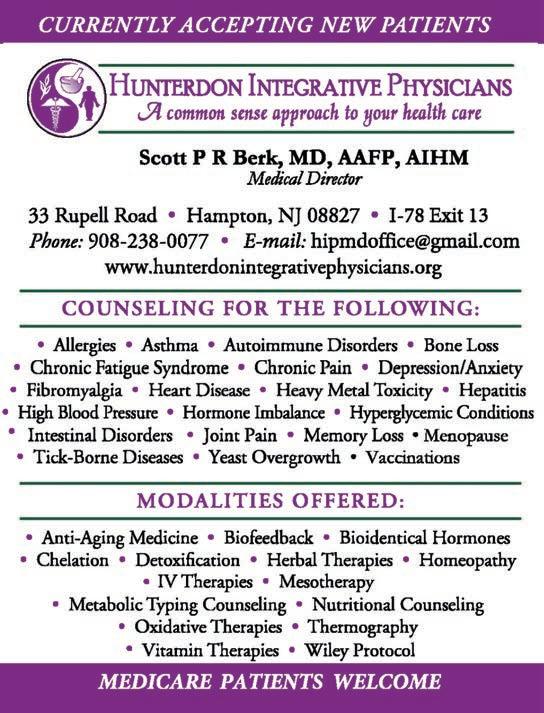
4 minute read
GUT TALK
S u s t a i n a b l e G o o d s f o r L o w I m p a c t L i v i n g Hemp • Bamboo • Alpaca • Organic Cotton
Clothing for Men, Women & Baby Natural Personal Care
Advertisement
Sustainable Paper • Fair Trade
Naturally Yours
The Organic Shop
81 Broadway • Jim Thorpe, PA 18229 570.325.8209 www.naturallyyoursorganics.com
GUT TALK TIPS FOR A HEALTHY MICROBIOME
by Melinda Hemmelgarn
It’s hard to imagine surrendering control of our minds and bodies to Marie Ruxton • LMT, CN • trillions of microorganisms, but an ever-growing body of research from the Human Microbiome Project shows how microbes living in and on our bodies affect and Chronic Pain & Movement Therapy even predict our physical and mental health. Myofascial Release Therapy The majority of these microorganisms, Mind-Body Makeovers Therapeutic Massage or microbiota, live within our large intestine. According to Kelly Tappenden, Ph.D., a PA #MSG002015 NJ #18KT00415900 registered dietitian and head of the Department of Kinesiology and Nutrition at the 628 Chestnut St • Emmaus • 610.965.2500 www.marieruxton.massagetherapy.com University of Illinois–Chicago, we have more microbial cells within our gut than we have human cells in our body. These microbes help digest food, regulate appetite, produce certain vitamins, synthesize chemicals such Ad change requests: as serotonin, metabolize carcinogens and regulate our immune system. She suggests that we think of them collectively as an organ that develops and changes as we age. “A huge proportion of your immune system is actually in your GI tract,” says Dan Peterson, assistant professor of chiropractic • acupuncture • massage pathology at the Johns Hopkins University Being Healthy is School of Medicine. Taking care of our gut microbes is paramount during times of stress and risk of infection. In their book, The Good Gut: Taking Control of Your Weight, Your Mood, and Your Long-Term a Lifestyle Choice. Choose to LiveWell. (Ad is shown at actual size. See page 2 for larger ads.) Dr. Robert W. Livingston III, DC, L.Ac. Health, Stanford researchers Justin and Dr. Jennifer Bollinger, DC, L.Ac. Erica Sonnenburg explain how healthy gut 8026 Hamilton Blvd. • Trexlertown, PA bacteria are essential for both metabolic Office/Fax: 610.395.5509 www.livewellintegratedhealth.com health and strong immunity, adding that the chemicals our gut microbes synthesize behave like drugs—they are absorbed into our bloodstream and influence our biology. Seattle-based biologist Ann Bikle refers to the colon as an “onboard medicine chest”. Unfortunately, warns Sonnenburg, physicians too often prescribe antibiotics, which wreak havoc on our microbiota, leaving us susceptible to disease-causing organisms.
Fiber for a Strong Defense
The Sonnenburgs define a microbiotafriendly diet as rich in plant-based, high-fiber foods and limited in meat and saturated animal fats. Low-fiber diets contribute to a decline in gut microbe diversity, resulting in a weakened immune system. “Fiber is fuel for the gut,” says Joanne Slavin, Ph.D., a registered dietitian and professor of food science and nutrition at the University of Minnesota-St. Paul. It’s naturally found in fruits, vegetables, beans, peas, whole grains, nuts and seeds.
Fermentable fibers such as fruit pectin, beta-glucans in barley and oats, and oligosaccharides in beans are metabolized by gut bacteria to produce short-chain fatty acids that provide energy to cells in the colon. Many fermentable fibers are called “prebiotics” because they promote the growth of beneficial gut bacteria. Inulin, for example, is a prebiotic fiber found naturally in onions, garlic, leeks, asparagus, wheat and oats.
Teresa Martin, a registered dietitian based in Bend, Oregon, who researches gut
health and disease prevention, recommends 35 to 50 grams of fiber per day to promote diverse, abundant and resilient gut microbes. For those over 50 years of age, the Institute of Medicine recommends 30 grams of dietary fiber per day for men and 21 grams for women. Most Americans get half the recommended amounts because highly processed, low-fiber foods are ubiquitous. Plus, popular gluten-free, keto and paleo diets limit whole grains. When buying packaged foods, check labels carefully and choose those providing at least three grams of fiber per serving.
A Healthy Microbiome for Life
Martin shares the following strategies for developing and preserving gut health: n Choose a vaginal birth, if pregnant; and breastfeed to help establish a healthy microbiome in the baby. n Choose an organic, plant-based diet. Aim for a variety of different plant species each day. n Enjoy fermented foods such as yogurt, kefir and sauerkraut, but be cautious with probiotic supplements. Only use those with proven safety and effectiveness. n Limit “microbial assassins”. Artificial sweeteners and emulsifiers such as polysorbate 80, carageenan and carboxymethylcellulose, typically found in processed foods, can lead to bloating, irritable bowel and inflammation.
n Enjoy physical activity; avoid sitting for more than 30 to 60 minutes.
n Go outside, enjoy fresh air and play in the dirt. n Reduce stress. Try yoga, meditation and mindfulness. n Sleep six to eight hours each night. n Think about gut microbiota every day, advises Martin. “Anything you can do to help fuel healthy microbes, no matter how small, will make a difference to your health.”
Melinda Hemmelgarn, the Food Sleuth, is an award-winning registered dietitian, writer and nationally syndicated radio host based in Columbia, MO. Reach her at FoodSleuth@gmail.com.
Make a Difference and Become an Ascend Hospice Volunteer Trained Massage, Reflexology and Aromatherapy Practitioners Companionship • Bereavement Counseling
formerly Care Alternatives
A Better Choice for Specialized Hospice Care







